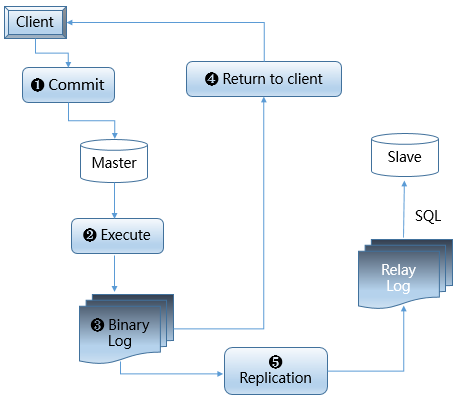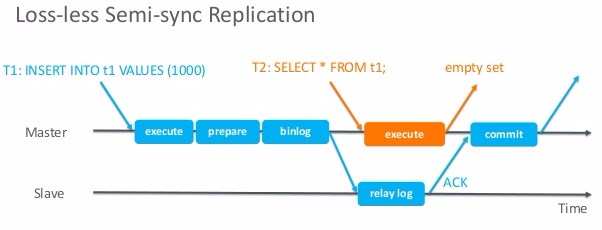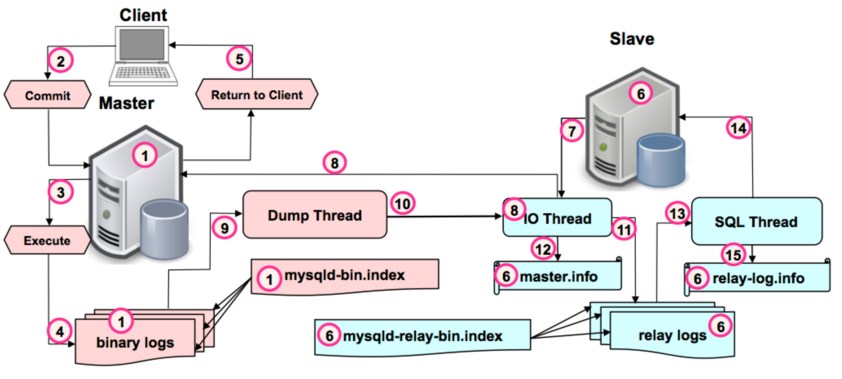Preface
As we all know,there're three kinds of replication in MySQL nowadays.Such as,asynchronous replication,(full)synchronous replication,semi-synchronous replication.What's the difference between them?First of all,let's see the intact architecture picture of MySQL replication:
What will master do?
What will slave do?
- connects to master
- IO Thread asks for data(binary logs) and gets them
- generates relay logs
- SQL Thread applies data(relay logs)
Method of different MySQL Replication
Generally speaking,the data changed on master will be continuously sent to slave.So the data on slave seems to be equal with the master.This mechanism is usually used to backup on slave(reduce the pressure of master),construct HA architecture(failover or separate reading/writing operations),etc.
Nevertheless,on account of different reasons,slave frequently defers in almost all the scenarios what's often grumbled by MySQL dba.Below are different kinds of MySQL replication.Let's see the details.
Since MySQL 3.2.22,this kind of replication was supported with statement format of binary log.Then,untill MySQL 5.1.5,row format of binary log was supported either.The mechanism of it is that as soon as the master dump thread has sent the binary logs to the slave,the master server returns the result to client.There's nothing to guarantee the binary logs are normally received by the slave(maybe the network failure occurs simultaneously).So it's unsafe in consistency what means your transactions will lose in the replication.This is also the original replication of MySQL.Here's the picture about the procedure:


1. Client sends dml operations to the master while the transaction starts.
2. Master executes these dml operations from client in transaction.
3. Generates some binary logs which contains the transaction information.
4. Master will return results to the client immediately after dump thread has sent these binary logs to slave.
5. Slave receives the binary logs by IO_Thread and apply the relay logs by SQL_Thread.
In step 4,master won't judge whether slave has received the binary logs (which are sent by itself) or not.If the master crashs suddenly after it has sent the binary logs,but slave does not receive them at all on account of network delay.Only if the slave takes over the application at this time,the committed transactions will miss which means data loss.This is not commonly acceptable in most important product systems especially in the financial ones.
Synchronous replication requires master to return results to client only after the transactions have been committed by all the slaves(receive and apply).This method will severely lead to bad performance on master unless you can guarantee the slaves can commit immediate without any delay(infact it's tough).Now,the only solution of synchronous replication is still the MySQL NDB Cluster.Therefore,it's not recommended to use synchronous replication way.
- semi-synchronous replication
Semi-synchronous replication seems a workaround of above two method which can strongly increase the consistency between master and slave.It's supported since MySQL 5.5 and enhanced in MySQL 5.7.What's the mechanism of semi-sychronouos replication?Master is permitted to return the result to client merely after only one slave has received binary logs,write them to the relay logs and returns an ACK signal to master.There're two ways of it,that is,after_commit & after_sync.Let's see the difference of them:
after_commit(Since MySQL 5.5):
In this method,master performs a commit before it receives ACK signal from slave.Let's suppose a situation that once master crashs after it commits a transaction but it hasn't receive the ACK signal from slave.Meanwhile,failover makes slave become the new master.How does the slave deal with then?Will the transaction lose?It depends.There're two scenarios:
- Slave has received the binary log,and then turns it into relay log and applys it.There's no transaction loss.
- Slave hasn't received the binary log,the transaction committed by master just now will lose,but the client won't fail(only inconsistent in replication).
Therefore,after_commit cannot guarantee lossless replication.after_commit is the default mode(actually it's the only mode can be use) which is supported by MySQL 5.5 & 5.6.
after_sync(since MySQL 5.7):

In the picture above,the t1 transaction shouldn't be lost because of the master merely commits to the storage engine after receive the ACK signal from slave.In spite of master may crash before receiving ACK signal,no transaction will lose as the master hasn't commit at all.Meanwhile,the t2 transaction also get consistent query here.
In order to improve the data consistency(since after_commit has avoidless deficiency),MySQL official enhances the semi-synchronous replication which can be called "loss-less semi-synchronous replication" in MySQL 5.7 by add after_sync mode in parameter "rpl_semi_sync_master_wait_point".
Caution,semi-synchronous replication may turn into asynchronous replication whenever the delay time of slave surpass the value which is specified in parameter "rpl_semi_sync_master_timeout"(default values is 10000 milliseconds).Why it is permitted?I'm afraid in order to consider the performance of master.Notwithstanding,you can also play a trick to prevent it from being converted over by set a infinite number in this parameter such as "10000000" or above.Especially in case that your product system is too important to not lose data.
Further more,to configure semi-sychronous replication,you should implement the optional plugin component "rpl_semi_sync_master",which can be check by using command "show plugins;"
Summary:
- Commonly,semi-sync replication is strongly recommended when implements MySQL replication nowadays(with gtid).
- I utterly recommend to upgrade product system to MySQL 5.7 in order to use "after_sync" mode which can avoid data loss.
- Be careful of specify an inappropriate value in parameter "rpl_semi_sync_master_timeout" which will cause converting semi-sync to async replication.
- MySQL 5.7 新特性之增强半同步复制
1. 背景介绍 半同步复制 普通的replication,即mysql的异步复制,依靠mysql二进制日志也即binary log进行数据复制.比如两台机器,一台主机(master),另外一台是从机( ...
- 深入MySQL复制(三):半同步复制
1.半同步复制 半同步复制官方手册:https://dev.mysql.com/doc/refman/5.7/en/replication-semisync.html 默认情况下,MySQL的复制是异 ...
- mysql半同步复制跟无损半同步区别
mysql半同步复制跟无损半同步复制的区别: 无损复制其实就是对semi sync增加了rpl_semi_sync_master_wait_point参数,来控制半同步模式下主库在返回给会话事务成功之 ...
- MySQL主从复制技术与读写分离技术amoeba应用
MySQL主从复制技术与读写分离技术amoeba应用 前言:眼下在搭建一个人才站点,估计流量会非常大,须要用到分布式数据库技术,MySQL的主从复制+读写分离技术.读写分离技术有官方的MySQL-pr ...
- MySQL异步、同步、半同步复制
异步复制 MySQL复制默认是异步复制,Master将事件写入binlog,提交事务,自身并不知道slave是否接收是否处理: 缺点:不能保证所有事务都被所有slave接收. 同步复制 Master提 ...
- MySQL高可用方案 MHA之四 keepalived 半同步复制
主从架构(开启5.7的增强半同步模式)master: 10.150.20.90 ed3jrdba90slave: 10.150.20.97 ed3jrdba97 10.150.20.132 ...
- MySQL主从复制技术(纯干货)
1.复制配置 主机一定要开启二进制日志(这里建议配置RBR) 每个主机和每个从机一定要配置一个位移的id,即server-id 每个从机配置一定要包含主机名称,日志名称,和位置 ...
- MySQL主从同步和半同步配置
mysql主从配置: 1,安装maraidb,使用国内yum镜像站下载:[root@localhost mysql]# cat /etc/yum.repos.d/MairaDB.repo # Mari ...
- MySQL主从复制技术的简单实现
配置环境: 主从服务器操作系统均为 ubuntu15.10 主从服务器MySQL版本均为 MySQL5.6.31 主服务器IP:192.168.0.178 从服务器IP:192.168.0.145 主 ...
随机推荐
- [小北De编程手记] : Lesson 04 - Selenium For C# 之 API 上
这一部分,我准备向大家介绍Selenium WebDriver的常用API,学习这部分内容需要大家最好有一些简单的HTML相关知识,本文主要涉及到以下内容: Selenium API:元素检查 Sel ...
- SpringBoot开发(改变环境属性、读取资源文件、Bean 配置、模版渲染、profile 配置)
1.概念 SpringBoot 开发深入 2.具体内容 在之前已经基本上了解了整个 SpringBoot 运行机制,但是也需要清楚的认识到以下的问题,在实际的项目开发之中,尤其是 Java 的 MVC ...
- 【Udacity】机器学习性能评估指标
评估指标 Evaluation metrics 机器学习性能评估指标 选择合适的指标 分类与回归的不同性能指标 分类的指标(准确率.精确率.召回率和 F 分数) 回归的指标(平均绝对误差和均方误差) ...
- mysql 更新sql报错:You can't specify target table 'wms_cabinet_form' for update in FROM clause
数据库里面有两个字段的位置不对,要把他们对调换下.因为没有数据库写的权限,需要用sql语句来实现.原来以为简单的 update table a set a.字段a=(select b字段 from t ...
- 3.用less浏览文件内容
less 命令是一个用来浏览文本文件的程序.纵观 Linux 系统,有许多人类可读的文本文件.less 程序为我们检查文本文件 提供了方便. 什么是“文本” 在计算机中,有许多方法可以表达信息.所有的 ...
- jquery实用技巧之输入框提示语句
我们在编写网页的时候不可避免的会遇到输入框,那么怎么设计输入框才能更加优雅呢?不同的人会有不同的答案,下面分享一个比较不错的设计. 效果图 细节 这个效果主要是通过JQuery来实现,我的思路如下: ...
- Linux-->Mysql:安装,测试
环境准备 mysql下载地址:https://dev.mysql.com/get/Downloads/MySQL-5.7/mysql-5.7.19-linux-glibc2.12-x86_64.tar ...
- [问题记录]cocos2dx编译打包apk过程&问题记录
目录: 1. 入门 2. 编译 3. 问题 4. 总结 5. 参考 ------------------------------------------------------------------ ...
- Redis添加访问密码
进入Redis的安装目录,找到redis.conf文件. 1.修改密码:使用vi命令打开redis.conf文件,先使用字符匹配查找到requirepass foobared对应的位置, 然后修改fo ...
- 原生js实现类名(class)的增、删
先判断是否有这个类名: function hasClass( elements,cName ){ return !!elements.className.match( new RegExp( &q ...






